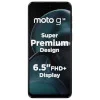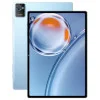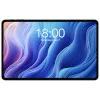Unisoc Tiger T616

Unisoc Tiger T616: A Budget Processor for Everyday Tasks and Beyond
Analysis of the capabilities and use cases of the mobile chip in 2025
Introduction
In the world of mobile technology, the choice of processor often determines how comfortable the smartphone experience will be. The Unisoc Tiger T616 is one of those chips that has found its niche in the budget and mid-range segments. Despite being somewhat outdated by 2025, it continues to be used in affordable devices. In this article, we will explore the advantages and disadvantages of the Tiger T616, who it is suitable for, and what to pay attention to when purchasing a smartphone based on it.
1. Architecture and Manufacturing Process: A Balance Between Efficiency and Cost
Cores and Frequencies
The Unisoc Tiger T616 is built on an 8-core architecture divided into two clusters:
- 2 Cortex-A75 cores with a frequency of up to 2.0 GHz for resource-intensive tasks.
- 6 Cortex-A55 cores with a frequency of up to 1.8 GHz for background processes and energy efficiency.
This configuration (2+6) allows for optimized power consumption by redistributing the load between powerful and energy-efficient cores. However, the 12 nm manufacturing process looks outdated in 2025 compared to chips from Qualcomm and MediaTek using 6–7 nm technology. This affects thermal performance and efficiency under prolonged workloads.
GPU Mali-G57 MP1
The Mali-G57 MP1 graphics accelerator is a single-core variant, which limits its capabilities in gaming. It supports Vulkan 1.1 and OpenGL ES 3.2, but is intended for medium graphics settings in mobile projects. For example, in Genshin Impact, expect around 20–25 FPS on low settings.
Cache and Memory
The processor works with LPDDR4X RAM (up to 8 GB) and eMMC 5.1/UFS 2.1 storage. Support for UFS 2.1 is a plus, as it speeds up application loading compared to eMMC.
2. Real-World Performance: From Social Media to Gaming
Everyday Applications
According to Geekbench 6 tests, the Tiger T616 scores:
- 453 points in Single-Core;
- 1509 points in Multi-Core.
These figures are sufficient for smooth operation with messengers, browsers (10–15 tabs), and office applications. However, heavy editors like Adobe Lightroom may experience some lag.
Gaming
The Mali-G57 MP1 handles light games (Among Us, Brawl Stars) at maximum settings, but in demanding titles (PUBG Mobile, Call of Duty: Mobile), you will need to lower the graphics to medium or low presets. In AnTuTu 10, the chip scores around 279,366 points, placing it in the same league as Snapdragon 680 and MediaTek Helio G88.
Multimedia and AI
- Video: Support for H.265 encoding/decoding (4K@30fps) allows for high-resolution content viewing.
- AI Tasks: The absence of a built-in NPU means that functions like scene recognition in the camera or voice assistants operate slower than in chips with separate neural processors.
Power Consumption and Heating
The 12 nm process and modest GPU/CPU frequencies help save battery life. With moderate use (social media, music, calls), the smartphone can last 1.5–2 days. However, during long gaming sessions, overheating is possible, especially in devices without cooling systems.
3. Integrated Modules: Connectivity and Navigation
Modem and Networks
The Tiger T616 is equipped with a 4G modem supporting LTE Cat.7 (up to 300 Mbps download speed). 5G is absent, which becomes a significant drawback in 2025, considering the spread of next-generation networks even in the budget segment.
Wi-Fi and Bluetooth
- Wi-Fi 5 (802.11ac) with support for dual bands (2.4 GHz and 5 GHz);
- Bluetooth 5.0 with improved connection stability for wireless headphones.
Navigation
The chip supports GPS, GLONASS, Galileo, and BeiDou, ensuring accurate positioning even in challenging conditions (mountains, dense urban environments).
4. Comparison with Competitors: Where Does Tiger T616 Excel?
Against Snapdragon 4 Gen 2
Qualcomm's Snapdragon 4 Gen 2 (4 nm) offers better energy efficiency, 5G support, and improved gaming performance (Adreno 619 vs. Mali-G57 MP1). However, smartphones with Snapdragon 4 Gen 2 start at $200, while devices with Tiger T616 start at $150.
Against MediaTek Helio G99
The Helio G99 (6 nm) shows higher AnTuTu scores (around 350,000 points) and comes with an improved GPU Mali-G57 MC2. But here too, the price difference is significant: smartphones with MediaTek G99 start at $180.
Conclusion: The Tiger T616 is a choice for those looking for the most affordable option. It may lag behind modern counterparts but compensates for this with its price.
5. Use Cases: Who is the Processor Suitable For?
- Everyday Tasks: Social media, calls, streaming video, light gaming.
- Photo and Video: Cameras up to 64 MP (with EIS support) can handle daytime shots, but night photos may be noisy due to a weak ISP.
- Long Battery Life: The chip is suitable for smartphones with batteries of 5000 mAh or more—it won’t drain their charge within half a day.
Not Suitable For:
- Hardcore gamers;
- Users who need 5G and advanced AI features.
6. Pros and Cons
Advantages:
- Low device cost (starting from $150);
- Sufficient performance for basic tasks;
- Support for UFS 2.1 and fast charging;
- Energy efficiency under moderate loads.
Disadvantages:
- Lack of 5G;
- Weak GPU for gaming;
- Outdated 12 nm manufacturing process;
- No NPU for AI optimizations.
7. Practical Tips: How to Choose a Smartphone with Tiger T616?
- Cooling: Look for models with copper pipes or graphite coatings if you plan to game.
- Display: An AMOLED display will enhance battery life, but even an IPS with a 90 Hz refresh rate will be comfortable.
- Memory: At least 6 GB RAM + 128 GB ROM is recommended for use in 2025.
- Battery: Ideally, a 5000 mAh battery with 18W charging support or higher.
Device Examples:
- Realme C67 ($160): 6.6" IPS, 50 MP camera, 5000 mAh battery.
- Infinix Note 14 ($170): AMOLED, 8 GB RAM, 33W charging.
8. Final Conclusion: Who is the Tiger T616 Suitable For?
This processor is a choice for:
- Budget-conscious users who value price;
- Students and teenagers using smartphones for studies and light entertainment;
- A second device or gadget for elderly individuals.
Main benefits include low cost, stable performance in everyday scenarios, and good battery life. However, if you want future-proofing with 5G and gaming capabilities, it’s better to look at more expensive chips.
Conclusion
The Unisoc Tiger T616 is an example of a balance between price and functionality. It may not impress with its performance but will serve as a reliable companion for those not willing to overpay for unnecessary features. In 2025, such processors remain relevant in developing markets and the ultra-budget device segment.
Basic
6x 1.8 GHz – Cortex-A55
GPU Specifications
Connectivity
Memory Specifications
Miscellaneous
Benchmarks
Phones with Tiger T616

Tablets with Tiger T616



Comparison of Devices with Tiger T616
Compared to Other SoC
Share in social media
Or Link To Us
<a href="https://cputronic.com/en/soc/unisoc-tiger-t616" target="_blank">Unisoc Tiger T616</a>